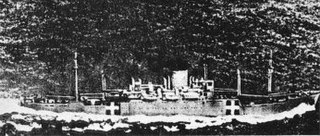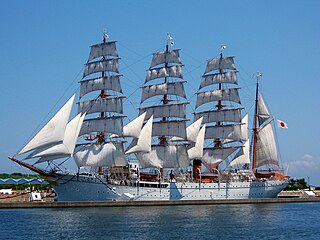Japanese ship names follow different conventions from those typical in the West. Merchant ship names often contain the word maru at the end, while warships are never named after people, but rather after objects such as mountains, islands, weather phenomena, or animals.

USS Bowfin (SS/AGSS-287), was a Balao-class submarine of the United States Navy named for the bowfin fish. Since 1981, she has been open to public tours at the USS Bowfin Submarine Museum and Park in Pearl Harbor, Hawaii, next to the USS Arizona Memorial Visitor Center.

USS Shark (SS-314), a Balao-class submarine, was the sixth ship of the United States Navy to be named for the shark, a large marine predator.

Nippon Yusen is Japanese shipping company and is a member of the Mitsubishi keiretsu. The company has its headquarters in Chiyoda, Tokyo, Japan and a fleet of about 800 ships, that includes container ships, tankers, bulk and woodchip carriers, Ro-Ro car carriers, reefer vessels, LNG carrier and cruise ships.
Toa Maru No 2 is a World War II Japanese transport ship sunk by the American submarine USS Searaven (SS-196) off Gizo, Solomon Islands on 25 November 1943.
Tango Maru (丹後丸), originally named Rendsburg, was a cargo ship built in Germany in 1925. It was sunk by an American submarine on February 25, 1944, while in the service of the Imperial Steamship Co., a Japanese government-owned company. The sinking cost about 3,000 passengers and crew their lives.

The Japanese aircraft carrier Taiyō was the lead ship of her class of three escort carriers. She was originally built as Kasuga Maru (春日丸), the last of three Nitta Maru class of passenger-cargo liners built in Japan during the late 1930s. The ship was requisitioned by the Imperial Japanese Navy (IJN) in early 1941 and was converted into an escort carrier. Taiyō was initially used to transport aircraft to distant air bases and for training, but was later used to escort convoys of merchant ships between Japan and Singapore. The ship was torpedoed twice by American submarines with negligible to moderate damage before she was sunk in mid-1944 with heavy loss of life.

The Nisshin Maru (日新丸) is the primary vessel of the Japanese whaling fleet and is the world's only whaler factory ship. It has a tonnage of 8,145 GT and is the largest member and flagship of the five-ship whaling fleet, headed by leader Shigetoshi Nishiwaki. The ship is based in Japan in Shimonoseki harbor and is owned by Tokyo-based Kyodo Senpaku, which is a subsidiary of the Institute of Cetacean Research.

HMS Terrapin was a British submarine of the third group of the T class. She was built as P323 by Vickers Armstrong, Barrow and Belliss and Morcom Ltd, and launched on 31 August 1943. So far she has been the only ship of the Royal Navy to bear the name Terrapin, after the animal of that name. Apart from a brief period in home waters off the Scandinavian coast, Terrapin served in the Far East for much of her wartime career.

Hikawa Maru (氷川丸) is a Japanese ocean liner that Yokohama Dock Company built for Nippon Yūsen Kabushiki Kaisha. She was launched on 30 September 1929 and made her maiden voyage from Kobe to Seattle on 13 May 1930. She is permanently berthed as a museum ship at Yamashita Park, Naka-ku, Yokohama.

Komagata Maru was a steamship owned by the Shinyei Kisen Goshi Kaisya of Japan. She was built as a cargo ship in 1890 and had previously been known as both SS Stubbenhuk and SS Sicilia while sailing for two different German owners. She was later renamed Heian Maru.

Sōya (宗谷) is a Japanese icebreaker that serves as a museum ship in Tokyo after a long and storied service spanning some of the 20th century's historic events. It is named for Sōya Subprefecture in Hokkaido.

The Kinesaki class food supply ship was a class of four reefer ships of the Imperial Japanese Navy (IJN), serving during and after World War II. Eleven vessels were planned under the Maru 4 Programme, Maru Rin Programme and Kai-Maru 5 Programme, however, only four vessels were completed.

Shinshū Maru was a ship of the Japanese Imperial Army during World War II. She was the world's first landing craft carrier ship to be designed as such, and a pioneer of modern-day amphibious assault ships. During some of her operations, she was known to have used at least four cover names, R1,GL,MT, and Ryujo Maru.

The Awa Maru (阿波丸) was a Japanese ocean liner owned by Nippon Yusen Kaisha. The ship was built in 1941–1943 by Mitsubishi Shipbuilding & Engineering Co. at Nagasaki, Japan. The vessel was designed for passenger service, but the onset of war by the time work was completed changed requirements, and she was requisitioned by the Japanese Navy. While sailing as a hospital ship under the protection of the Red Cross in 1945, she was torpedoed by USS Queenfish (SS-393), killing all but one of 2,004 people aboard.

The Chichibu Maru (秩父丸) was a Japanese passenger ship which, renamed Kamakura Maru, was sunk during World World II, killing 2,035 soldiers and civilians on board.

Kaiwo Maru (海王丸) is a Japanese former training barque. She was built by Kawasaki Shipbuilding Corporation in Kobe, and was launched on 27 January 1930 alongside her sister ship Nippon Maru. She was operated by the Tokyo Institute for Maritime Training to train officers for Japan's merchant marine. At the beginning of World War II, her sailing rig was removed and she served as a training and postwar transport motorship. In 1955, her rig was reinstalled and she resumed her training voyages until she was replaced in 1989 by her successor, also named Kaiwo Maru. She is now a museum ship located in Imizu, Toyama.

The Yamashio Maru class consisted of a pair of auxiliary escort carriers operated by the Imperial Japanese Army during World War II. They were converted from tankers. Only the name ship was completed during the war and she was sunk by American aircraft before she could be used.

Nippon Maru (日本丸) is a Japanese museum ship and former training vessel. She is permanently docked in Yokohama harbor, in Nippon Maru Memorial Park.

















